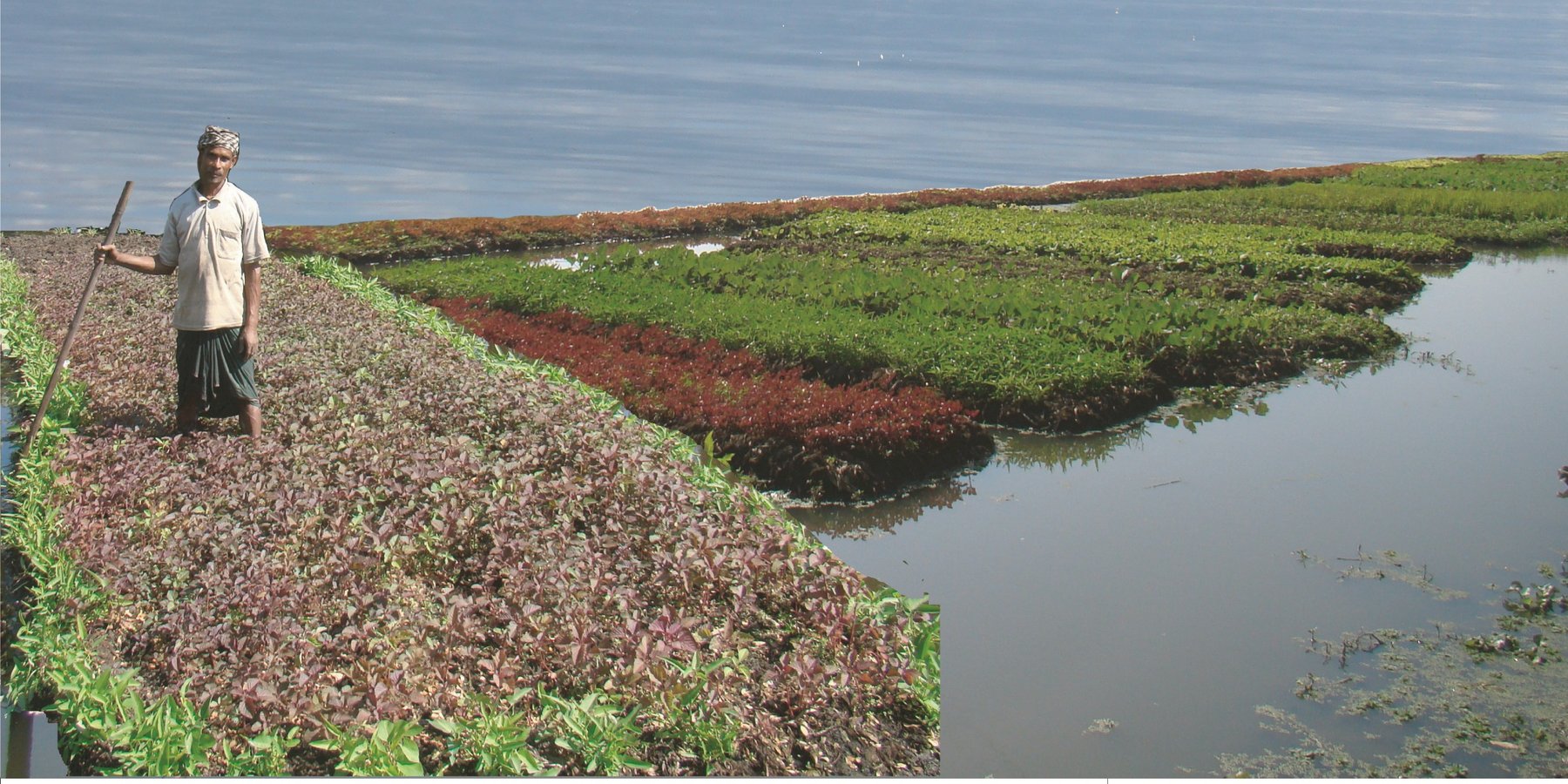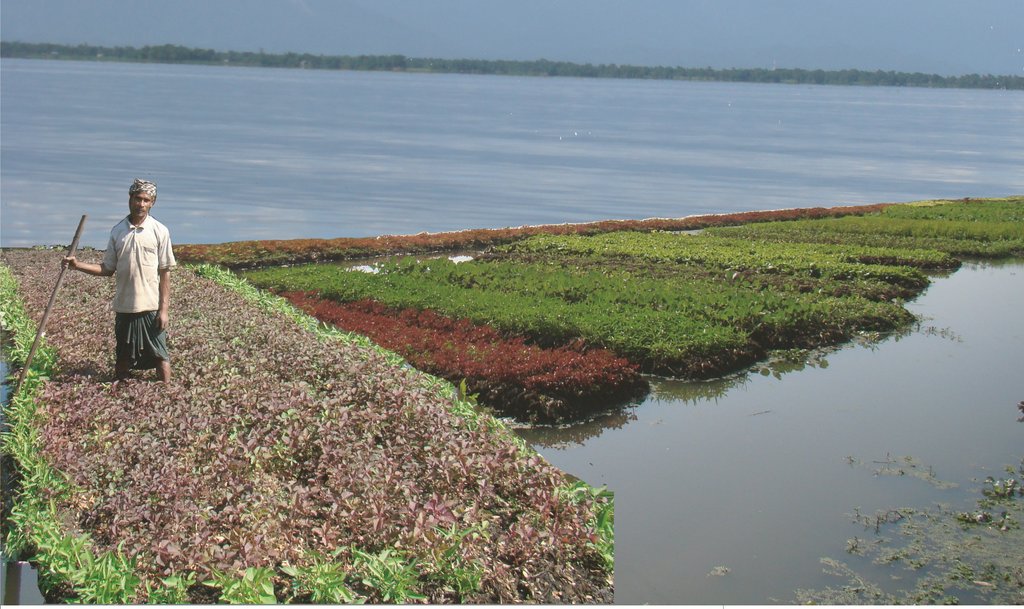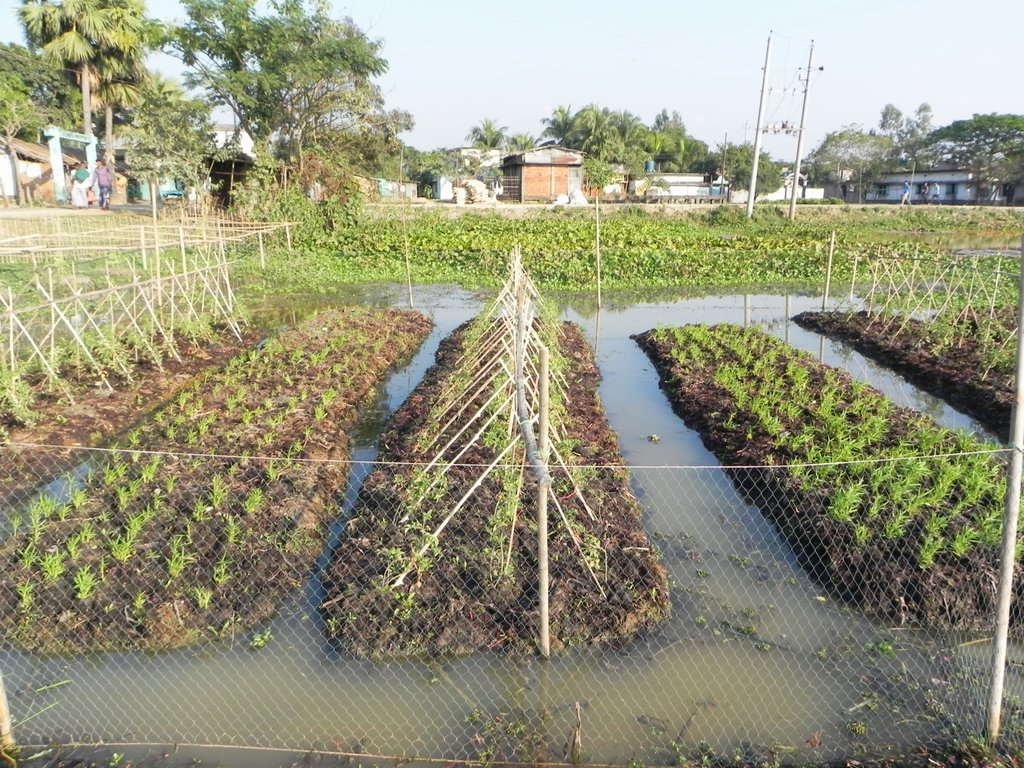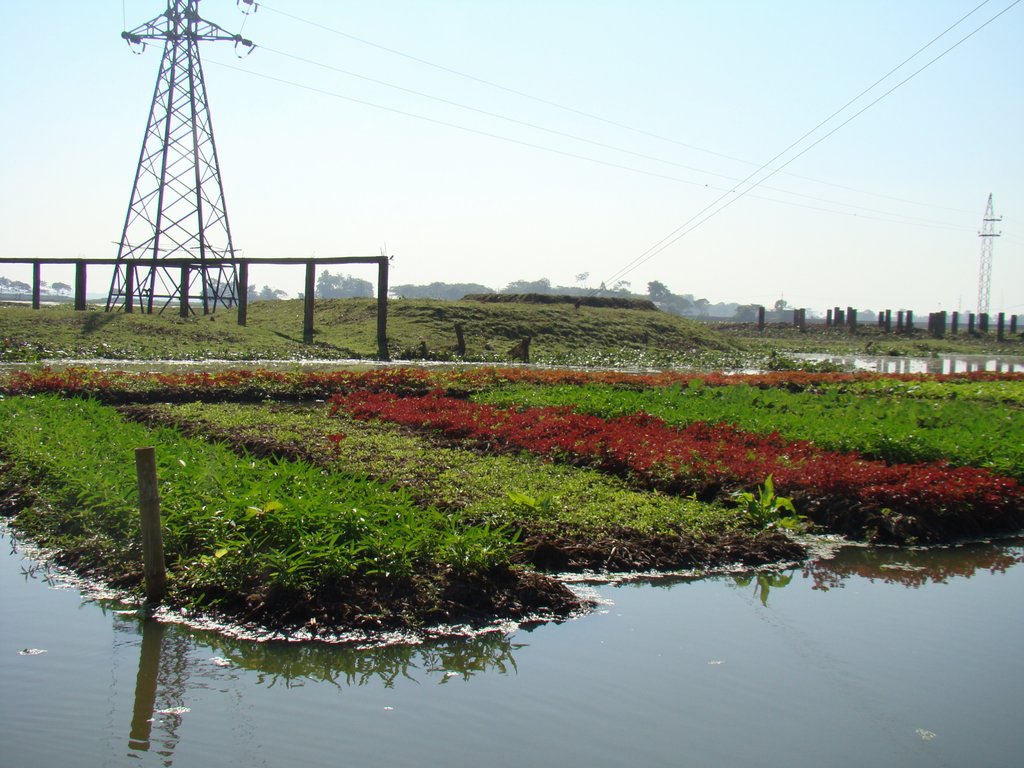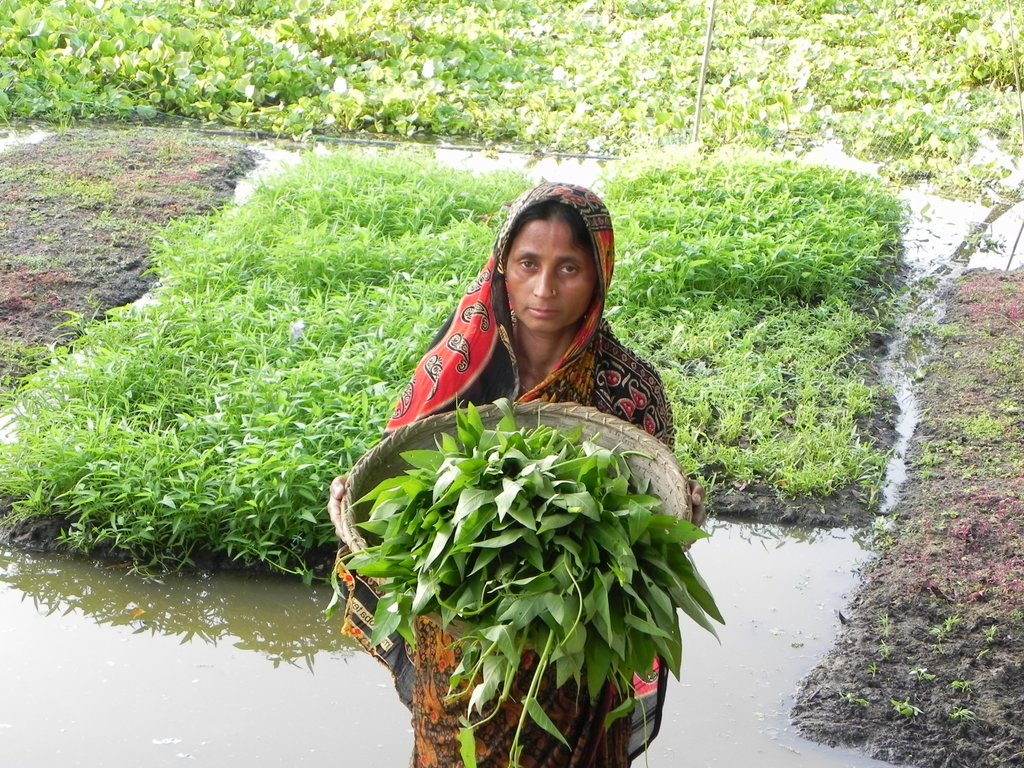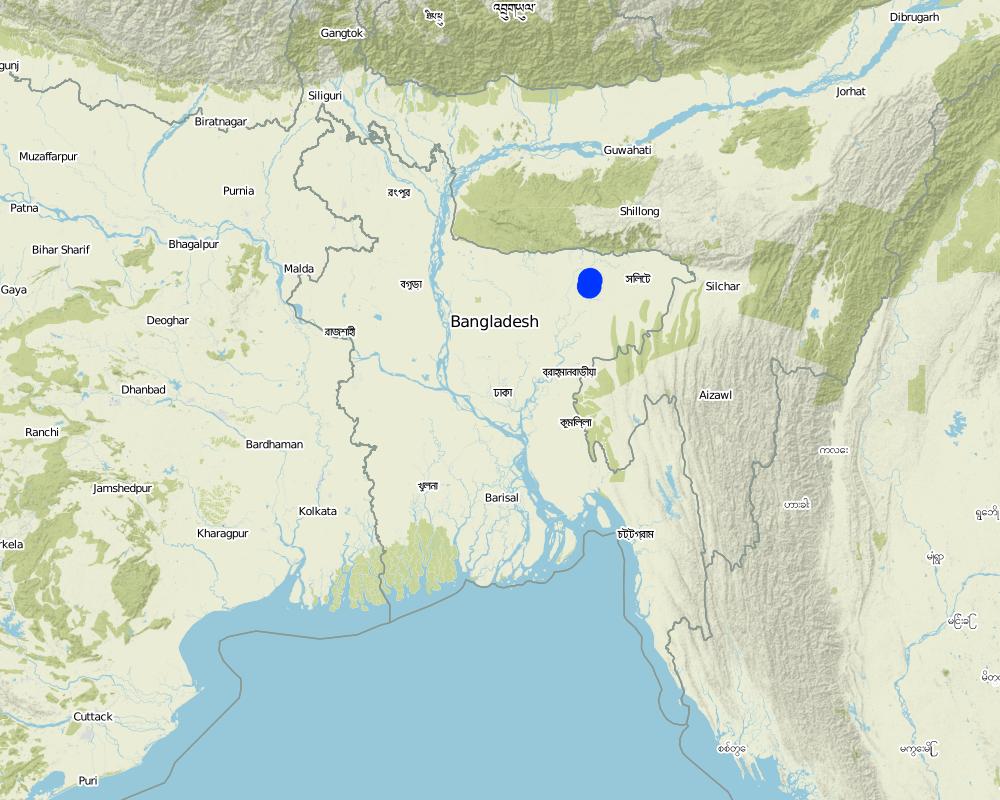Floating Garden [孟加拉国]
- 创建:
- 更新:
- 编制者: Shamim Ahamed
- 编辑者: Eveline Studer
- 审查者: Alvin Chandra, Alexandra Gavilano
"Baira" or "Dhap", floating bed
technologies_620 - 孟加拉国
查看章节
全部展开 全部收起1. 一般信息
1.2 参与该技术评估和文件编制的资源人员和机构的联系方式
关键资源人
SLM专业人员:
Hasan Md. Zahid
+880 2 55052051-3 / +880 1716388648
zahid.hasan@helveas.org / zahidforestry@gmail.com
HELVETAS Swiss Intercooperation
House-13/A NE (K), Road-83, Gulshan-2, Dhaka, Post code-1212, Bangladesh
孟加拉国
有助于对技术进行记录/评估的项目名称(如相关)
Book project: where people and their land are safer - A Compendium of Good Practices in Disaster Risk Reduction (DRR) (where people and their land are safer)有助于对技术进行记录/评估的机构名称(如相关)
HELVETAS (Swiss Intercooperation)1.3 关于使用通过WOCAT记录的数据的条件
(现场)数据是什么时候汇编的?:
05/10/2016
编制者和关键资源人员接受有关使用通过WOCAT记录数据的条件。:
是
1.4 所述技术的可持续性声明
这里所描述的技术在土地退化方面是否存在问题,导致无法被认为是一种可持续的土地管理技术?:
否
注释:
Context specific environmentally friendly technology
2. SLM技术的说明
2.1 技术简介
技术定义:
Floating Garden is a traditional technology, practiced in the southern parts of Bangladesh locally called “Baira” or “Dhap”. The technology allows producing crops, vegetables and seedlings in areas where farming land is scarce and where the land is flodded or water logged for more than six months in a year.
2.2 技术的详细说明
说明:
Floating gardensa are a traditional practice in south central districts of Bangladesh since long time, and has been promoted by government extension agency and development organizations in different parts of the country with technical improvements. With this technology, crops (mainly vegetables) are cultivated on floating garden beds in areas where the land inundated for more than six months in a year.
Establishment:
The basic input and main raw material to prepare the floating garden bed are water hyacinths (Eichhornia crassipes). In some cases bamboo sticks are also used to make the floating beds more resistant. The floating gardens are of different size, with a standard size per bed during preparation of 1.5 - 1.8 meter wide, 10 -11 meter long and 1 - 1.3 meter above water level. However, considering local context- such as wave action, size of water body, presence of a wetland - the bed size may vary, also depending on whether compost is added on the top. The establishment of the floating gardens are very cheap in terms of raw material and require mainly human manual labour for its establishment, without material costs for maintenance.
The garden can be used for two purposes: for vegetable production and for vegetable seedling production.
In water logged areas (where water remains for the whole year) floating beds are mainly used for vegetable production. Almost any type of vegetables can be grown in the floating bed. Production of leafy vegetables proofed to be most profitable. In addition, all types of vegetable seedlings and rice seedlings can produced in floating garden based on demand. In other areas, which are only inundated temporarily, floating garden can be used for both vegetable and seedling production. In this second case seedlings can be transfered from the garden to the fields on the main land immediately after receding of the water. This practice can save 2 to 3 weeks time of vegetable or rice production in winter season. This is a crucial advantage considering the trend to shorter growing periods due to unpredictable early spring rains.
A key advantage of floating gardening is the fact that heavy rainfalls usually do not have any negative effect on culture of the floating gardens, which are a highly effective and beneficial risk reduction and climate change mitigation technology. Floating gardens can further contribute to food security and improved nutrition for poor households, and it is a source for additional income by making use of cheap and abundant local input resources. Different NGOs improved and promoted this technology in north-west and north-east parts of Bangladesh since 2000. Since 2011 also the public agricultural extension agencies promote this technology.
As an overall goal this technology aims at protecting people’s assets for agricultural production from damages due to seasonal floods and provide options for alternative income resources. The floating garden technology is designed as measure to protect effectively from yearly floods. It might not be robust enough for extreme events with heavy storms and waves. Smaller repairing can be done by the owners themselves. In case of major damages the beds can be replaced by new ones, since the investment costs are very low. In the shallow areas the floating beds may become ordinary garden beds or fields during dry season.
2.3 技术照片
2.4 技术视频
注释、简短说明:
This video was developed for the capitalization of practical experience and instructive training materials. The short movie describes step by step the establishment and the benefits of the floating gardens. In a short interview governmental and other local partners share their positive experience of the technology and describe how the technology is mainstreamed by Government agencies.
The video is available online with following link: https://youtu.be/AK_qTm2pUsw
日期:
29/02/2012
位置:
Sunamganj, Bangladesh
摄影师的名字:
HELVETAS Swiss Intercooperation
注释、简短说明:
The video documentary was prepared to capitalise and diseminate the experience of the Floating Gardens as an innovative technology for vegetable cultivation in wetlands.
日期:
01/06/2012
位置:
Sunamganj, Bangladesh
摄影师的名字:
HELVETAS Swiss Intercoopartion
2.5 已应用该技术的、本评估所涵盖的国家/地区/地点
国家:
孟加拉国
区域/州/省:
Sylhet division, Sunamganj district
有关地点的进一步说明:
Paschim Pagla, Patharia and Shimulbak unions under South Sunamganj sub-district, Charnarchar and Rajanagar unions under Derai sub-district
注释:
More than 1000 floating beds have been prepared in 8 sub-districts of Sunamganj district in northeastern Bangladesh and documented accordingly. HELVETAS supported government agencies (District Administration and Department of Agricultural Extension-DAE) to document and promote the technology further.
Map
×2.6 实施日期
如果不知道确切的年份,请说明大概的日期:
- 不到10年前(最近)
2.7 技术介绍
详细说明该技术是如何引入的:
- 通过项目/外部干预
注释(项目类型等):
The technology was first piloted through implementation of “Livelihoods, Empowerment and Agroforestry (LEAF)” project. Later on, the technology was expanded through implementation of “Agricultural Innovation for Eliminating Extreme Poverty” (AIEEP 2009-2012) and through Unnoti -Prosperity in Haor project (2013-2016).
3. SLM技术的分类
3.1 该技术的主要目的
- 改良生产
- 降低灾害风险
- 适应气候变化/极端天气及其影响
- 创造有益的经济影响
- 创造有益的社会影响
- improve household food security / nutrition
3.2 应用该技术的当前土地利用类型

农田
- 一年一作
主要农作物(经济作物及粮食作物):
Vegetables and seedlings

水道、水体、湿地
- 沼泽、湿地
主要产品/服务:
Vegetable and Seedling
如果由于技术的实施而导致土地用途发生变化,则在技术实施前说明土地利的用途。:
earlier these wetland areas were mainly fallow (not used for any productive purpose). During monsoon season, the waterbodies naturally count on fish reserves, which are captures by local farmers including landless poor. Water hyacinth of these wetlands were partially used as fodder, though most of it was decomposed naturally without use.
3.3 有关土地利用的更多信息
其它(比如洪水后):
- post-flooding
注释:
Floating gardens are prepared on the water body, hence can absorb sufficient water without additional irrigation.
每年的生长季节数:
- 2
具体说明:
Winter and early Summer
3.4 该技术所属的SLM组
- 改良的地面/植被覆盖
- 湿地保护/管理
- 家庭花园
3.5 技术传播
具体说明该技术的分布:
- 适用于特定场所/集中在较小区域
3.6 包含该技术的可持续土地管理措施

农艺措施
- A5:种子管理,改良品种

结构措施
- S11:其它

管理措施
- M1:改变土地使用类型
注释:
floating beds, which are adapted to changing water levels (floods).
change of land/water management from pure wetlands to gardens.
3.7 该技术强调的主要土地退化类型

水质恶化
- Hs:地表水良变化
注释:
More frequent and severe seasonal floodings
3.8 防止、减少或恢复土地退化
具体数量名该技术与土地退化有关的目标:
- 减少土地退化
- 适应土地退化
注释:
The technology is used to adapt to natural seasonal flooding, to prevent damages caused by floods by using wet lands for crop production.
4. 技术规范、实施活动、投入和成本
4.1 该技术的技术图纸
4.2 技术规范/技术图纸说明
• Dimensions: The floating beds are of different size. Standard size at the time of preparation 1.5 - 1.8 meter wide, 10-11 meter long and 1.0-1.3 meter height.
• Floating beds should not cover more than 30% area of the respective water body (wetland area) in order to keep enabling environment for other aquatic resources (e.g. fishes).
• Construction material used: The basic and main ingredient/material for the preparation of the floating garden are water hyacinths (Eichhornia crassipes). In some cases, bamboo sticks are also used to increase its resistance. If available, composts may be applied on the top of floating beds, though not compulsory.
4.3 有关投入和成本计算的一般信息
具体说明成本和投入是如何计算的:
- 每个技术区域
注明尺寸和面积单位:
1 decimal for 5 floating beds
如果使用本地面积单位,请注明换算系数为1公顷:
1 hectare = 247 decimals
其它/国家货币(具体说明):
BDT
注明雇用劳工的每日平均工资成本:
1 man-day cost BDT 300 (USD 3.85)
4.4 技术建立活动
| 活动 | 措施类型 | 时间 | |
|---|---|---|---|
| 1. | Bed preparation (by hired labour) | 结构性的 | August-September |
| 2. | Seeding, care and maintenance, harvesting | 农业学的 | September-March |
注释:
After full harvesting of vegetable in March, the bed (decomposed water hyacinth) can be used as organic compost for other crops in cultivable land.
4.5 技术建立所需要的费用和投入
| 对投入进行具体说明 | 单位 | 数量 | 单位成本 | 每项投入的总成本 | 土地使用者承担的成本% | |
|---|---|---|---|---|---|---|
| 劳动力 | Hired labour cost for bed establishment | persons day | 10.0 | 300.0 | 3000.0 | |
| 劳动力 | Bed management cost (seeing, care, harvest ect.) | persons day | 90.0 | 300.0 | 27000.0 | 100.0 |
| 植物材料 | Seeds per year | kg | 25.0 | 100.0 | 2500.0 | 100.0 |
| 施工材料 | Bamboo | bamboo quantity | 2.0 | 100.0 | 200.0 | |
| 施工材料 | Rope and lubricants | lumpsum | 1.0 | 250.0 | 250.0 | |
| 技术建立所需总成本 | 32950.0 | |||||
4.6 维护/经常性活动
注释:
No maintenance required
4.7 维护/经常性活动所需要的费用和投入(每年)
注释:
No specific maintenance costs during the year/season required. Small repairments are part of the labour costs of agronomic mesures to be done in paralele with care work.
4.8 影响成本的最重要因素
描述影响成本的最决定性因素:
In case the inputs, mainly water hyacinths, are not available at the selected sites, this increases the material and/or labour costs for hyacinths to be transported from distant locations.
All indicated costs refer to yearly costs, since the beds ususally have to be restablished every year.
5. 自然和人文环境
5.1 气候
年降雨量
- < 250毫米
- 251-500毫米
- 501-750毫米
- 751-1,000毫米
- 1,001-1,500毫米
- 1,501-2,000毫米
- 2,001-3,000毫米
- 3,001-4,000毫米
- > 4,000毫米
指定年平均降雨量(若已知),单位为mm:
3365.00
有关降雨的规范/注释:
The driest month is December, with 6 mm of rain. The greatest amount of precipitation occurs in June, with an average of 712 mm.
注明所考虑的参考气象站名称:
Sunamganj, Bangladesh (data source: www.en.climate-data.org)
农业气候带
- 潮湿的
The average annual temperature is 25.0 °C in Sunamganj.
5.2 地形
平均坡度:
- 水平(0-2%)
- 缓降(3-5%)
- 平缓(6-10%)
- 滚坡(11-15%)
- 崎岖(16-30%)
- 陡峭(31-60%)
- 非常陡峭(>60%)
地形:
- 高原/平原
- 山脊
- 山坡
- 山地斜坡
- 麓坡
- 谷底
垂直分布带:
- 0-100 m a.s.l.
- 101-500 m a.s.l.
- 501-1,000 m a.s.l.
- 1,001-1,500 m a.s.l.
- 1,501-2,000 m a.s.l.
- 2,001-2,500 m a.s.l.
- 2,501-3,000 m a.s.l.
- 3,001-4,000 m a.s.l.
- > 4,000 m a.s.l.
说明该技术是否专门应用于:
- 凹陷情况
5.3 土壤
如有可能,附上完整的土壤描述或具体说明可用的信息,例如土壤类型、土壤酸碱度、阳离子交换能力、氮、盐度等。:
Not applicable for this technology as floating bed prepare on surface of water body
5.4 水资源可用性和质量
地下水位表:
表面上
地表水的可用性:
过量
水质(未处理):
仅供农业使用(灌溉)
水的盐度有问题吗?:
否
该区域正在发生洪水吗?:
是
规律性:
频繁
关于水质和水量的注释和进一步规范:
Each year seasonal monsoon flooding. However, early flash (pre monsoon flood) occur only every 3 years.
5.5 生物多样性
物种多样性:
- 中等
栖息地多样性:
- 中等
关于生物多样性的注释和进一步规范:
Water bodies are rich with diverse aquatic organisms
5.6 应用该技术的土地使用者的特征
定栖或游牧:
- 定栖的
生产系统的市场定位:
- 混合(生计/商业
非农收入:
- 收入的10-50%
相对财富水平:
- 非常贫瘠
- 贫瘠
个人或集体:
- 个人/家庭
- 团体/社区
机械化水平:
- 手工作业
性别:
- 女人
- 男人
土地使用者的年龄:
- 青年人
- 中年人
5.7 应用该技术的土地使用者拥有或租用的平均土地面积
- < 0.5 公顷
- 0.5-1 公顷
- 1-2 公顷
- 2-5公顷
- 5-15公顷
- 15-50公顷
- 50-100公顷
- 100-500公顷
- 500-1,000公顷
- 1,000-10,000公顷
- > 10,000公顷
这被认为是小规模、中规模还是大规模的(参照当地实际情况)?:
- 小规模的
5.8 土地所有权、土地使用权和水使用权
用水权:
- 自由进入(无组织)
- 个人
注释:
The farmers establish floating gardens in public water body and in private water body (with verbal agreement of water body owners).
5.9 进入服务和基础设施的通道
健康:
- 贫瘠
- 适度的
- 好
教育:
- 贫瘠
- 适度的
- 好
技术援助:
- 贫瘠
- 适度的
- 好
就业(例如非农):
- 贫瘠
- 适度的
- 好
市场:
- 贫瘠
- 适度的
- 好
能源:
- 贫瘠
- 适度的
- 好
道路和交通:
- 贫瘠
- 适度的
- 好
饮用水和卫生设施:
- 贫瘠
- 适度的
- 好
金融服务:
- 贫瘠
- 适度的
- 好
6. 影响和结论性说明
6.1 该技术的现场影响
社会经济效应
生产
作物生产
注释/具体说明:
crop production during rainy season becomes possible
生产区域
注释/具体说明:
innundated fallow water bodies can be used for food production, which increases surface for production.
收入和成本
农业收入
注释/具体说明:
People produce vegetable/seedlings and increase their cash income through selling of the production surplus in the market. It also provide food and additional nutrition support to the farm family. Consequently, poor farmer families increase their resilience to food insecurity and income fluctuation.
收入来源的多样性
注释/具体说明:
Additional income for floating gardeners, which is particularly valuable for poor i.e. landless people.
经济差异
SLM之前的数量:
0
SLM之后的数量:
1
工作量
注释/具体说明:
slight but no significant increase in workload for bed preparation, care and harvesting
社会文化影响
食品安全/自给自足
注释/具体说明:
Vegetable production for home consumption contribute to households food security, which is particularly critical during rainiy season.
健康状况
注释/具体说明:
Improved nutrition through household consumption of own vegetable production.
土地使用权/用水权
注释/具体说明:
People establish floating garden on public water bodies or individual water bodies, based on a (verbal) agreement and regulated by a free or rent.
文化机会
注释/具体说明:
Increase aesthetic view of wetlands, water becomes valuable productive surface with plants and flowers.
SLM/土地退化知识
注释/具体说明:
Increased knowledge on disaster risk reduction technology, based on local resources and capacities adjusted to the situation of socially and economically disadvantaged groups.
社会经济弱势群体的情况
注释/具体说明:
Its an simple "self-help" technology, which proveds new income options particularly for most vulnerable. It can be replicated by disadvantaged groups them-selfs landless and increases cohesion among the poor and very poor community members.
生态影响
生物多样性:植被、动物
植被覆盖
注释/具体说明:
floating gardens increase vegetation coverage on the water surface
生物量/地上C
注释/具体说明:
the material of old floating gardens, usualy at the end of the rainy season, are used as compost/ fertiliser for crop land.
动物多样性
注释/具体说明:
With the floating gardens there are less water hyacinths spread over the surface, which increases sunlight and oxygen on the water. Hence, this contributes to good conditions for the growth of fish and other aquatic resources.
减少气候和灾害风险
洪水影响
注释/具体说明:
Negative impacts due to floods, such as damages and limited production can be substantially reduced with this technology, which increases production and income during flooding period.
6.2 该技术的场外影响已经显现
对邻近农田的破坏
SLM之前的数量:
0
SLM之后的数量:
1
注释/具体说明:
reduce/protect wave action and decrease soil erosion of the adjacent/raised land.
damage by wave erosion
注释/具体说明:
The floating gardens reduce wave erosion on neighbours' fields, since the beds protect adjacent land and assets from soil erosion.
有关影响评估的意见:
No specific research have been made on off-site and environmental impact of the floating garden technology.
6.3 技术对渐变气候以及与气候相关的极端情况/灾害的暴露和敏感性(土地使用者认为的极端情况/灾害)
气候有关的极端情况(灾害)
水文灾害
| 该技术是如何应对的? | |
|---|---|
| 比较和缓的(河道)洪水 | 好 |
| 山洪暴发 | 非常好 |
其他与气候有关的极端情况(灾害)
| 其它(具体说明) | 该技术是如何应对的? |
|---|---|
| increasingly unpredictable start and duration of monsoon/rainy season, floods | 适度 |
其他气候相关的后果
其他气候相关的后果
| 该技术是如何应对的? | |
|---|---|
| 延长生长期 | 好 |
注释:
with the effect of climate change monsoon have become more impredictable: starting sooner, ending later.
The techology allows to plant and grow seedlings already before the end of rainy season, and can therefor mantain or even extend the growing period.
6.4 成本效益分析
技术收益与技术建立成本相比如何(从土地使用者的角度看)?
短期回报:
积极
长期回报:
稍微积极
技术收益与技术维护成本/经常性成本相比如何(从土地使用者的角度看)?
短期回报:
非常积极
长期回报:
非常积极
注释:
Considering only one season - particualrly for intensive raining seasons - the gardens have positive benefits.
Considering a longer time period with less intensive rainy seasons, the fact that the bed ususally have to be reestablished every year might require an important work from a land user's perspective (therefore rate with slightly less benefits)
6.5 技术采用
- 1-10%
如若可行,进行量化(住户数量和/或覆盖面积):
about 1000
在所有采用这项技术的人当中,有多少人是自发地采用该技术,即未获得任何物质奖励/付款?:
- 10-50%
6.6 适应
最近是否对该技术进行了修改以适应不断变化的条件?:
否
6.7 该技术的优点/长处/机会
| 土地使用者眼中的长处/优势/机会 |
|---|
| In the Haor area’ (local wetland ecosystem flooded during monsoon season) water hyacinths are naturally abundant. These are the basis and substrate for floating gardens. Hence, the technology makes use of local plants as resorces, as substrate of the floating garden. If required, floating bed can easily moved from one location to another. After preparation of the bed, no additional hard labour is required. |
| There is hardly pest infestation, therefore no use of pesticides is required. |
|
After final harvest, the beds are used as organic compost for the fields. Further, the farmers either can sell or use the substrate of the garden as compost. |
| This simple technology and can easily be replicated. |
| During heavy rainfalls and storms, the crop are not damaged by floods since on a floating surface. |
| 编制者或其他关键资源人员认为的长处/优势/机会 |
|---|
|
Through this technology, crops can be produced on the water surface. The usually abundant water hyacinth are used as a productive resource, which increases the surface for crop production. In contexts, such as Bangladesh, where land resources are scarce this opens production options in public/abundant water bodies for landless farmers, who can earn money within a short period and with little investment. |
|
The production for home consumption improves nutrition, contributes to food security and surplus is sold at the market, which contribute to the income of poor households. The technology is useful for increasing production for home consumption and market. |
6.8 技术的弱点/缺点/风险及其克服方法
| 土地使用者认为的弱点/缺点/风险 | 如何克服它们? |
|---|---|
| In some cases there are water leeches available in the water body. Therefore, people become afraid of preparing floating beds. | People polish diesel/kerosene oil in their body before preparation of floating beds to protect them from attack of leeches. |
|
In some cases, water hyacinths are not available locally, consequently farmers face difficulties to prepare floating beds in distant places. Further challenges are the guarding/security of the gardens, the time consuming establishment of the beds. |
Introduce and prepare floating gardens by supporting whole groups instead of individual famers. |
| Wave action and local streams may drift away the floating beds | Use bamboo pole to fix floating beds and prevent that they are floating away. |
| 编制者或其他关键资源人员认为的弱点/缺点/风险 | 如何克服它们? |
|---|---|
| Non-availability of adequate quantity of water hyacinth in same place every year. | Prepare bed in the places where water hyacinth are available and then move the beds in to the desired locations. |
| Due to heavy wave action or heavy water flow, floating beds could be broken/destroyed. | Prepare small size beds. |
| Lack of awareness and willingness of farmers to practice this technology. | Organise meeting, training, demonstration, and learning visit. |
7. 参考和链接
7.1 信息的方法/来源
- 实地考察、实地调查
10 times field visits and 28 informants.
- 与土地使用者的访谈
25
- 与SLM专业人员/专家的访谈
4
7.2 参考可用出版物
标题、作者、年份、ISBN:
A learning documentary on Floating Vegetable Garden, HELVETAS Swiss Intercooperation, March-2012, ISBN: 978-984-33-5313-9
可以从哪里获得?成本如何?
https://youtu.be/AK_qTm2pUsw
标题、作者、年份、ISBN:
Innovative Vegetable Cultivation, HELVETAS Swiss Intercooperation, 2012
可以从哪里获得?成本如何?
https://youtu.be/lhiraDjPymU
标题、作者、年份、ISBN:
Piloting Schemes Systematic Integration of DRR in LEAF - December 2010
可以从哪里获得?成本如何?
https://assets.helvetas.org/downloads/drr_capex.pdf
7.3 链接到网络上可用的相关信息
标题/说明:
A learning documentary on Floating Vegetable Garden, HELVETAS Swiss Intercooperation, March-2012, ISBN: 978-984-33-5313-9
URL:
https://youtu.be/AK_qTm2pUsw
标题/说明:
Innovative Vegetable Cultivation, HELVETAS Swiss Intercooperation, 2012
URL:
https://youtu.be/lhiraDjPymU
标题/说明:
Islam and Atkins, 2007. Indigenous floating cultivation: a sustainable agricultural practice in the wetlands of Bangladesh. Development in Practice 17:130-136.
URL:
https://www.jstor.org/stable/25548185?seq=1#page_scan_tab_contents
标题/说明:
Irfanullah et al., 2008. Introduction of floating gardening in the northeastern wetlands of Bangladesh for nutritional security and sustainable livelihood. Renewable Agriculture and Food Systems 23:89-96
URL:
http://nopr.niscair.res.in/bitstream/123456789/11064/1/IJTK%2010(1)%2031-38.pdf
标题/说明:
Irfanullah et al., 2011. Floating gardening in Bangladesh: a means to rebuild lives after devastating flood. Indian Journal of Traditional Knowledge 10:31-38.
URL:
http://nopr.niscair.res.in/bitstream/123456789/11064/1/IJTK%2010(1)%2031-38.pdf
标题/说明:
Irfanullah, 2013. Floating Gardening: a local lad becoming a climate celebrity? Clean Slate 88:26-27.
URL:
http://floodresilience.net/solutions/item/floating-gardening-a-local-lad-becoming-a-climate-celebrity
链接和模块
全部展开 全部收起链接
无链接
模块
无模块


